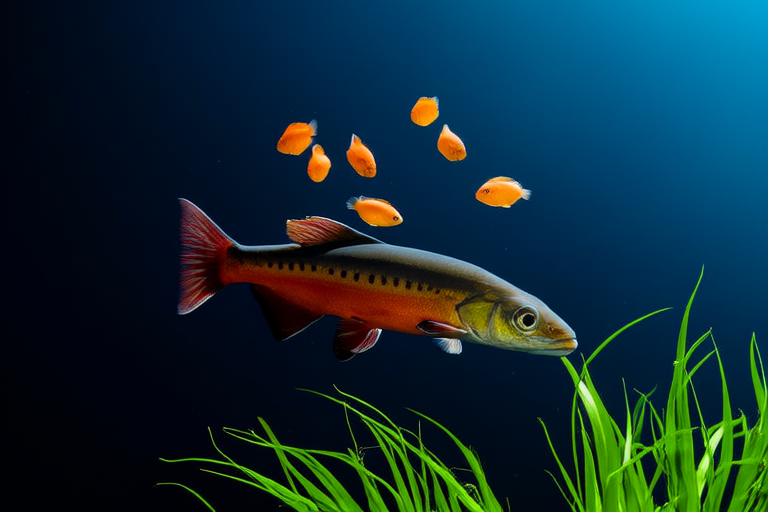From Tank to Treasure: How to Successfully Breed Rajah Cichlids
Welcome to an exciting journey into the world of Rajah cichlid breeding. Whether you’re a seasoned aquarist or just starting out, this guide will provide you with all the information you need to successfully breed these magnificent fish. We’ll cover everything from setting up the perfect tank to caring for your fry, ensuring you have a rewarding experience.
Understanding the Rajah Cichlid
The Rajah cichlid, scientifically known as Aequidens rivulatus, is a stunning fish native to South America. These cichlids are popular among hobbyists due to their vibrant colors and fascinating behaviors. Their robust nature and adaptability make them suitable for both beginners and advanced aquarists.
Ideal Tank Setup
Creating the right environment is crucial for the health and breeding success of Rajah cichlids. Start by choosing a spacious tank; a minimum of 55 gallons is recommended for a pair. A larger tank allows more space for territories and reduces stress.
Substrate choice plays a significant role. Fine gravel or sand mimics their natural habitat and helps maintain water quality. Decorations such as driftwood, rocks, and caves offer hiding spots and breeding sites. Plants like Java moss or Amazon swords can be beneficial but ensure they’re sturdy enough to withstand the territorial behavior of these cichlids.
Proper filtration and aeration are vital. Use a high-quality filter capable of handling large volumes of water efficiently. Ensure there’s adequate circulation without creating strong currents that could stress the fish.
Water Parameters
Maintaining optimal water conditions is key to the well-being of Rajah cichlids. Aim for a pH range between 6.0 and 7.5, slightly acidic to neutral. Soft to moderately hard water with a conductivity of 80-150 µS/cm is ideal. Regular water changes (about 20% weekly) help keep parameters stable and reduce nitrate levels.
Temperature should be maintained at around 75-80°F (24-27°C). Use a reliable heater and thermometer to monitor and adjust as necessary. Stability in temperature and chemistry encourages breeding behavior.
Diet Specifics
Rajah cichlids are omnivorous, thriving on a varied diet. Provide a mix of high-quality flake food, pellets, and live or frozen foods. Brine shrimp, bloodworms, and daphnia offer essential nutrients. Supplement their diet with vegetables like blanched spinach or peas for fiber and vitamins.
Feeding should be done twice daily, offering only what they can consume within a few minutes to prevent overfeeding and water pollution.
Pairing Techniques
Selecting compatible pairs requires careful observation. Healthy males and females typically exhibit distinct secondary sexual characteristics. Males often display brighter colors and extended fins, while females may show plumper bodies during breeding readiness.
Introduce potential pairs gradually under close supervision. Observe their interactions closely. If aggression arises, separate them immediately. Successful pairings usually establish territories together and engage in courtship rituals like fin displays and nudging.
Breeding Habits
Rajah cichlids are substrate spawners, meaning they lay eggs on flat surfaces. Once paired, prepare a spawning site with flat stones or ceramic tiles. The female deposits eggs, which the male fertilizes externally. Both parents guard the eggs vigilantly.
Eggs hatch after about 3-4 days, depending on temperature. Fry remain attached to the substrate for several days before becoming free-swimming. During this period, parents continue to protect them diligently.
Fry Care
Newborn fry require special attention. Feed them infusoria initially, then progress to finely crushed flakes or specialized fry food. Frequent small feedings ensure they grow healthily. Monitor water quality closely, performing frequent partial water changes.
Gradually introduce larger, more substantial foods as they grow. By the time they reach juvenile size, they can join the main tank community if adequately sized.
Common Challenges Faced During Breeding
Despite best efforts, challenges may arise. One common issue is egg-eating. To mitigate this, consider providing alternative spawning sites or removing aggressive individuals temporarily.
Another challenge is ensuring proper water conditions. Sudden changes can stress fish and affect breeding success. Regular testing and adjustments are essential.
In some cases, parental neglect may occur. If this happens, remove the fry and raise them separately until they’re large enough to fend for themselves.
Tips for Maintaining a Healthy Environment
Regular maintenance keeps your aquarium thriving. Perform routine checks for algae growth and address it promptly. Clean filters regularly to maintain efficiency. Keep decorations clean to prevent bacterial buildup.
Invest in good quality test kits to monitor water parameters accurately. This proactive approach prevents problems before they escalate.
Troubleshooting Breeding Issues
If breeding fails, first review environmental factors. Ensure water parameters are correct and stable. Check for signs of disease or stress in your fish. Sometimes, simply giving the pair more time or space can resolve issues.
Consult with experienced breeders or online forums for additional insights. Sharing experiences can provide valuable solutions.
Conclusion
Breeding Rajah cichlids offers a rewarding experience filled with discovery and learning. By understanding their needs and providing a nurturing environment, you can enjoy the beauty and complexity of these remarkable fish. Remember, patience and dedication are key. Happy breeding!
